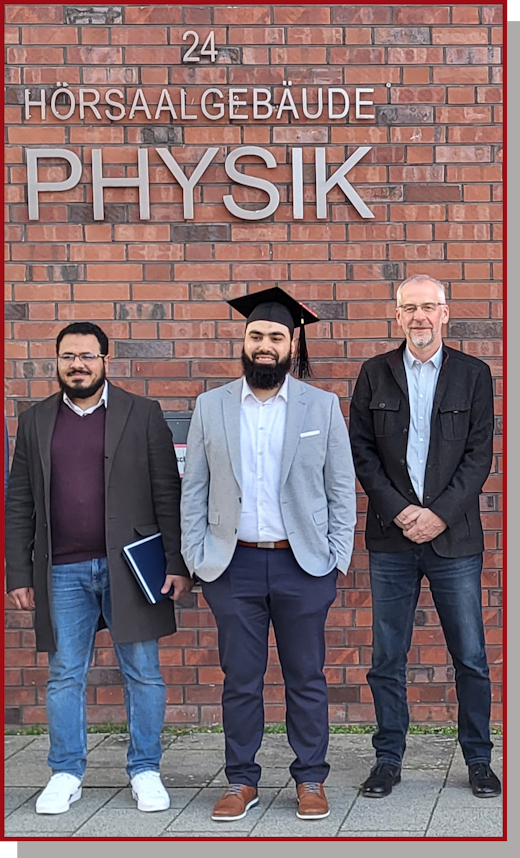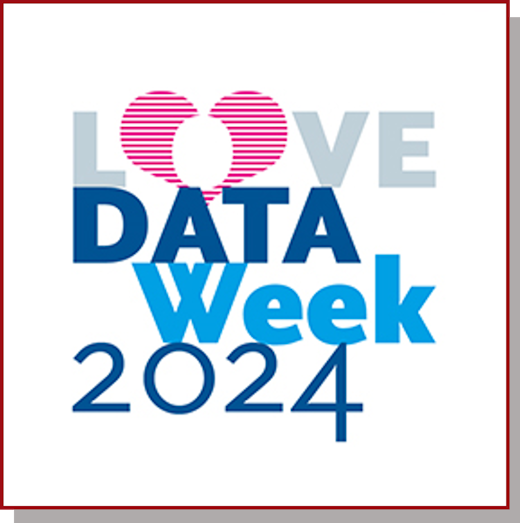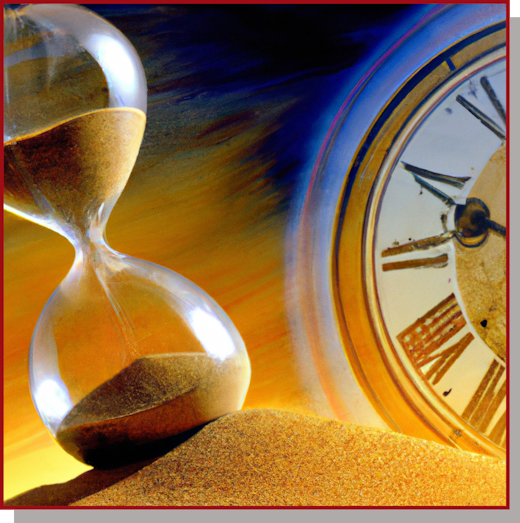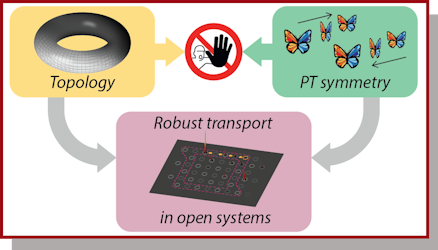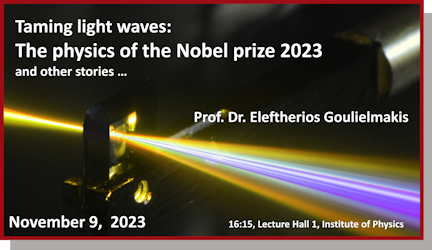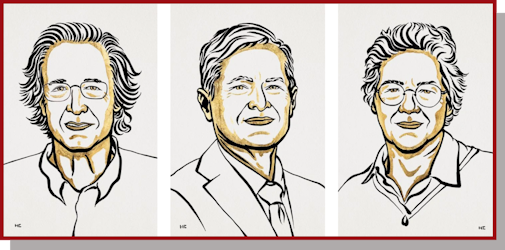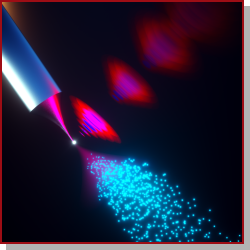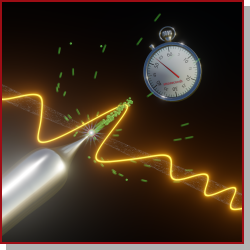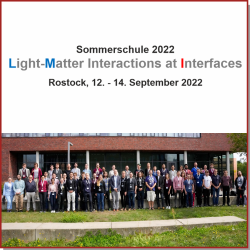| 2024 |
|---|
15.03.2024
LiMatI PhD student completes doctorate and starts postdoc career
We are thrilled to announce an important milestone of our colleague Moyassar Meshhal, who has now officially obtained a PhD in theoretical physics!
His research journey took him into the fascinating field of computer simulations of 2D materials. His PhD topic was exploring potential environmental applications of 2D materials using atomistic computational simulations. "I am grateful for the journey so far and look forward to the scientific discoveries to come!" said Moyassar Meshhal following his defense on 07.03.2024.
The next step on his career path is a stay here at the Institute of Physics as a postdoctoral researcher in Prof. Redmer's group. Here he will work on simulations of warm dense matter to study elements under extreme conditions.
Moyassar Meshhal would like to thank the supervisors of his doctoral project, Prof. Dr. Oliver Kühn and Dr. Ashour Ahmed, for their support and for everything he has learned from them.
The SFB LiMatI wishes Moyassar Meshhal every success and all the best for his upcoming postdoc adventure.

13.03.2024
Dr. Hannah Jürß strengthens INF team in CRC LiMatI
The CRC LiMatI is very pleased to announce the integration of Dr. Hannah Jürß as a postdoctoral researcher in the INF project, which will be an enriching addition to the dynamic INF team.
In her role, Dr. Jürß will act as a crucial link between the INF project and the research groups at LiMatI. She will have a significant impact on the project through her tireless efforts to optimize the daily workflows of our researchers. Her main focus will be on providing comprehensive support for various aspects of data management, which strongly emphasizes our commitment to research excellence.
Dr. Jürß recently completed her PhD under the supervision of Prof. Dieter Bauer in the Department of Physics. Her dissertation focused on the generation of high harmonics in topological haldanite systems, which underlines her deep understanding of physics. With her wealth of expertise, Dr. Jürß will be a competent advocate for the goals of the INF project.
The wait has undoubtedly been worth it, and we now warmly welcome Dr. Jürß to her new role in the CRC LiMatI.
01.02.2024
Online lecture series on the international LoveDataWeek 2024
Love Data Week (LDW) is a global week of action focused on research data and research data management.
With the theme "My Kind of Data", the worldwide love of data will be celebrated through a variety of events from February 12 to 16, 2024.
The FDM initiatives in German-speaking countries are aiming to generate more attention for research data management through various events and formats during Love Data Week.
Topic highlights
- What is research data management?
- Research data management in the humanities and applications
- Version management with Git
- Ways to publish research data
The event will take place via Zoom.
26.01.2024
Leap Year Colloquium 2024
2024 is the 506th leap year since the introduction of the Gregorian calendar in 1582.
For 73 years now, the Institute of Physics has been honoring such a year with a special colloquium, for which contributions can still be submitted until 08.02.2024.
When: Thursday, 29.02.2024 3:00 pm
Where: Lecture Halll 1, Institute of Physics
FAQ: What is a leap year?
A leap year is a year that contains an extra day to bring the calendar in line with astronomical time. A regular year has 365 days, but the actual time it takes the Earth to orbit the Sun (a so-called tropical year) is about 365.2422 days. To compensate for this discrepancy, we add an extra day every four years. This corrects the calendar and brings it closer to astronomical reality. If we did not do this, the seasons would shift over time and our calendar would no longer match the seasonal phenomena.
To find out whether a particular year is a leap year, we can apply the leap year rule:
- A year that is divisible by 4 is a leap year.
- Exception: A year that is divisible by 100 is not a leap year unless it is also divisible by 400.
19.01.2024
Staying the course despite rough seas – Protecting light beams from gain and loss.
An international cooperation of physicists from the University of Rostock, the cluster of excellence ct.qmat, the Julius Maximilians University of Würzburg and the Indiana University Indianapolis (IUPUI) have demonstrated for the first time that robust and stable propagation of light is possible in systems interacting with their environment. Previously, it was thought that such open systems inevitably would exhibit amplification or damping. Their findings have recently been published in the renowned journal Nature Materials.
Whether describing the orbits of planets or the inner workings of the atom, a key paradigm in physics is the conservation of energy: While different forms of energy may be converted into one another, the total amount of energy is typically assumed to be constant over time. Along these lines, physicists tend to go through great lengths to ensure that the system they are trying to describe does not interact with its environment. Yet, as it turns out, the dynamics of a system can also be stable if the gain and loss of energy are distributed in a systematic fashion such that they cancel each other under all conceivable conditions, which can be ensured by so-called parity-time (PT) symmetry: When simultaneously exchanging gain and loss, and mirroring the geometric arrangement of its components, the system appears unchanged. Far from being a purely academic notion, PT symmetry has paved the way for a deeper understanding of open systems.
The fascinating physical phenomena associated with PT symmetry are the specialty of Prof. Alexander Szameit at the University of Rostock. His research group harnesses laser-inscribed photonic waveguides as “circuits for light” to explore the dynamics of discrete systems. In their custom photonic chips, laser light can mimic the behavior of natural and synthetic materials alike, making them an ideal testbed for a large variety of physical theories. In this vein, the scientists around Prof. Szameit managed to combine PT symmetry with the concept of topology. Szameit explains: “Topological insulators have attracted a lot of attention in the last years because of their fascinating ability to convey a lossless stream of electrons or light along their boundary. The unique capability to suppress the impact of defects and scattering makes them especially interesting for all kinds of technological applications.”
Yet, until now, such robust boundary states were thought to be fundamentally incompatible with open systems. In their joint effort, the researchers from Rostock, Würzburg and Indianapolis could show that apparent paradox can be resolved by distributing gain and loss dynamically in time. The first author, PhD student Alexander Fritzsche elaborates: “The light propagating along the boundary of our open system is like a hiker traversing mountainous terrain. Despite all ups and downs, they will inevitably end up back at the initial elevation. Similarly, the light propagating within the protected edge channel of our PT-symmetric topological insulator will never be exclusively amplified or damped, and can therefore retain its amplitude on average while enjoying the full robustness afforded by topology.”
These findings constitute an important contribution to the fundamental understanding of topological insulators and open systems, and may open the gates to a new generation of advanced circuits for electricity, light or even sound waves.
This research was funded by the German Research Foundation (DFG) and supported by the Alfried Krupp von Bohlen und Halbach Foundation.
Original Publication: Fritzsche et al., „Parity-Time-symmetric Photonic Topological Insulator”, Nature Materials (2024). DOI: 10.1038/s41563-023-01773-0
Contakt:
Prof. Dr. Alexander Szameit
Solid-State Optics Group
Institute of Physics
University of Rostock
Phone.: +49 381 498-6790
E-Mail: alexander.szameituni-rostockde

01.01.2024
CALL FOR NOMINATIONS
The 20th IUPAP Prize for Young Scientists in Atomic, Molecular and Optical Physics 2024 includes a certificate, a medal, an award of 1,000 euros and an invited presentation at ICAP 2024.
The deadline for submitting nominations is March 31, 2024.
| 2023 |
|---|
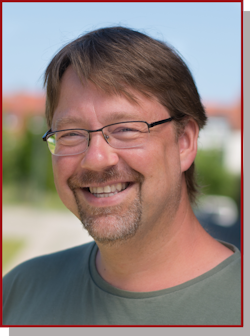
16.11.2023
Alexander Szameit is a Fellow of Optica
In November 2023, the board of the international specialist society Optica elected the 2024 Fellows.
Among them is Alexander Szameit, Professor of Physics at the University of Rostock and researcher at the Collaborative Research Center 1477 LiMatI.
An Optica Fellowship is reserved for people who have made an outstanding contribution to the field of optics and photonics. Alexander Szameit is researching the physics of light, in particular in order to use it in a new type of computer: the optical quantum computer.
Alexander Szameit studied physics at the Universities of Halle and Jena, where he also completed his doctorate. After research stays in Hawaii, Australia and Israel, he was appointed to the Chair of Experimental Solid State Optics at the University of Rostock in 2016. He is one of the most frequently cited scientists in his field worldwide.
The Optica organization is dedicated to promoting the generation, application, archiving and dissemination of knowledge in optics and photonics worldwide. Founded in 1916, it is the leading organization for scientists, engineers, business people, students and others interested in the science of light. Optica's renowned publications, meetings, online resources and in-person activities foster discovery, shape applications and accelerate scientific, technical and educational achievement.
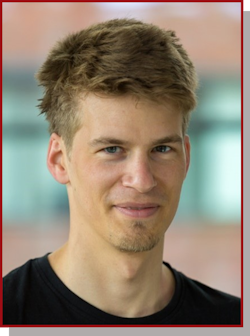
14.11.2023
Congratulations to the doctorate
In July 2023, the Faculty of Mathematics and Natural Sciences at the University of Rostock awarded Benjamin Liewehr (M.Sc.) the degree of Dr. rer. nat.
His dissertation project on ultrafast nanoplasma dynamics in dielectrics was carried out in the strong-field nanophysics group of Prof. Thomas Fennel and is closely linked to research in the field of strong-field physics and attosecond research within the CRC 1477 - Light-Matter Interaction at Interfaces. Immediately after completing his dissertation, he found an exciting job in industry and is currently working at Liebherr MCCtec Rostock GmbH.
The SFB LiMatI congratulates!
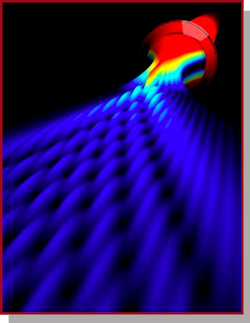
03.11.2023
Announcement: Saturday University starts
The popular Saturday University of the Mathematic Faculty of Natural Sciences starts into the winter semester 2023/2024.
The current lecture series will be opened by our LiMatI Prof. Dr. Alexander Szameit with the title "A Light Story - A Short History of Light".
When: November 4, 2023, at 11:00 am
Where: Lecture hall 1, Institute of Physics, Albert-Einstein-Straße 24
The lecture series is aimed at all those interested in science. The topics are presented in a generally understandable way and are intended to stimulate discussion.
Subsequent dates: November 11 / November 18 / November 25
Further information and the program can be found here.
02.11.2023
Announcement: Lecture on the Nobel prize on 09.11.2023
Taming light waves ... and other stories
The Nobel Prize in Physics this year was awarded for the generation of ultra-short light pulses. These pulses are so brief (namely 0.000000000000000001 seconds = 1 attosecond) that they can be used to „photograph“ the motion of electrons in matter. This field of research, known as attosecond physics, is a crucial area of study at the Institute of Physics and the Collaborative Research Center LiMatI. Professor Eleftherios Goulielmakis worked in the research group of the newly crowned Nobel laureate Ferenc Krausz before his appointment to Rostock and conducted groundbreaking experiments in the field of attosecond physics.
In the Physics Colloquium Professor Goulielmakis will speak on the topic „Taming light waves: The physics of the Nobel prize 2023 and other stories...“ (in English). Interested individuals are cordially invited!
Wann: on November 9, 2023, at 4:15 PM ,
Wo: Lecture Hall 1, Institute of Physics, Albert-Einstein-Straße 24
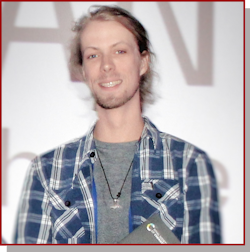
17.10.2023
Poster presentation award
Our PhD student Julian Schröer received a poster presentation award from the Royal Society of Chemistry at Flatlands beyond Graphene 2023 in late September. The award was supported by the journals Nanoscale Horizons, Nanoscale and Nanoscale Advances.
Julian Schröer works in the LiMatI subproject W04 and investigates the physics at interfaces between organic dye molecules and inorganic semiconductors. At the conference, he presented his results on photoluminescence spectroscopy of heterostructures from both materials. Among other things, his investigations focus on a potential charge transfer between the materials, which forms the basis for applications in photovoltaics.
The SFB LiMatI congratulates!
04.10.2023
Nobel prize physics 2023
The three researchers Pierre Agostini, Ferenc Krausz and Anne L'Huillier are awarded for developing the experimental methods to generate extremely short light pulses to study electron dynamics in matter. These attosecond pulses make it possible to explore the superfast motion processes and energy changes of electrons in atoms and molecules.
Fast-moving events flow into each other when perceived by humans, just like a film that consists of still images is perceived as continual movement. If we want to investigate really brief events, we need special technology. In the world of electrons, changes occur in a few tenths of an attosecond – an attosecond is so short that there are as many in one second as there have been seconds since the birth of the universe. The laureates’ experiments have produced pulses of light so short that they are measured in attoseconds, thus demonstrating that these pulses can be used to provide images of processes inside atoms and molecules.
In 1987, Anne L’Huillier discovered that many different overtones of light arose when she transmitted infrared laser light through a noble gas. Each overtone is a light wave with a given number of cycles for each cycle in the laser light. They are caused by the laser light interacting with atoms in the gas; it gives some electrons extra energy that is then emitted as light. Anne L’Huillier has continued to explore this phenomenon, laying the ground for subsequent breakthroughs.
In 2001, Pierre Agostini succeeded in producing and investigating a series of consecutive light pulses, in which each pulse lasted just 250 attoseconds.
At the same time, Ferenc Krausz was working with another type of experiment, one that made it possible to isolate a single light pulse that lasted 650 attoseconds.
Our LiMatI physicist Eleftherios Goulielmakis contributed to the results at that time while working on his PhD thesis under Ferenc Krausz.
Press release of Nobel foundation
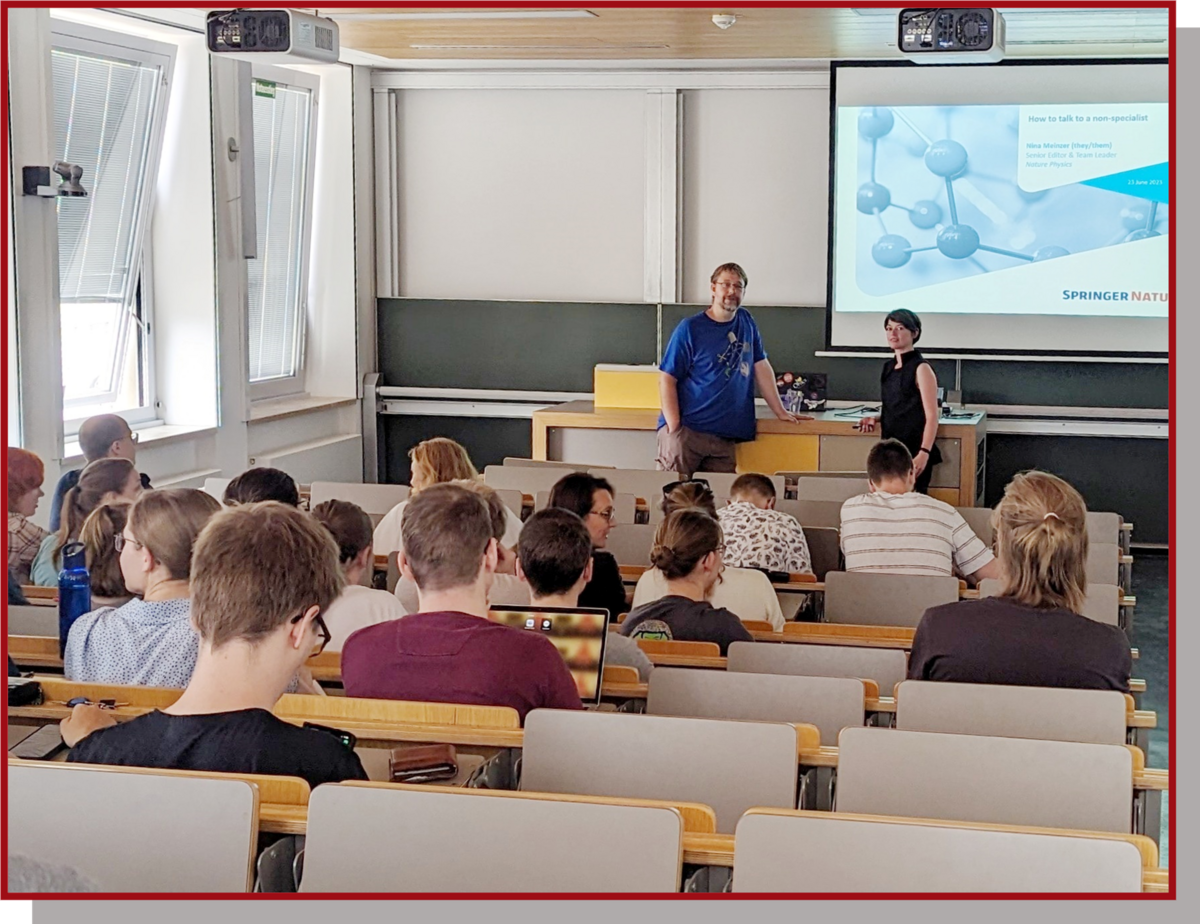
23.06.2023
Talk: Dr. Nina Meinzer
On Friday, June 23, 2023 at 2 pm, Dr. Nina Meinzer (Senior Editor & Team Leader Nature Physics) gave a talk on the topic:
How to talk to a non-specialist
The talk was part of the joint SFB 1270 ELAINE and SFB 1477 LiMaI lecture series "Women in Science and (Bio-)Engineering".
We thank all visitors for their participation!
26.04.2023
Controlled tunneling
How short can the time window be in which electrons can be released from metals under the control of a light field? Researchers of LiMatI project S05 were able to answer this question, which is essential for future electronic circuits, in a collaborative experimental and theoretical study together with scientists from Erlangen and Konstanz with the help of a trick. By means of an extremely precisely adjustable superposition of two different laser fields, we have succeeded for the first time in measuring the tunneling of electrons from metals down to a few tens of attoseconds and in controlling the ultrafast electronic quantum dynamics. The findings could enable electronic signal processing that is up to a million times faster than current technology and were recently published (Dienstbier et al., Nature 616, 702-706 (2023)).
- To the original article
- Press releases: FAU Erlangen-Nürnberg
25.01.2023
Electrons in the fast lane
Within LiMatI project S05 a study on the generation and measurement of the shortest electron pulse to date was published in Nature (Kim et al., Nature 613, 662-666 (2023)). The pulse was generated using lasers to release electrons from a tiny metal tip and lasted only 53 attoseconds, that is 53 billionths of a billionth of a second. The study sets a new speed record in man-made control of electric currents in solid materials and opens new possibilities for improving the performance of electronics and information technologies, as well as for developing new scientific methods for visualizing phenomena in the microcosm at ultimate speeds.
- To the original article
- Press releases: University of Rostock
- Video: Electrons in the fast lane
| 2022 |
|---|
13.07.2022
LiMatI Summer School 2022 finished
From September 12 to 14, 2022, the first LiMatI Summer School took place at the Institute of Physics of the University of Rostock. In lectures and hands-on tutorials, especially interested master students, PhD students and PostDocs could learn basic skills for research in the SFB LiMatI (from exfoliation of 2D materials to numerical solution of Maxwell's equations). We thank all visitors for their participation!
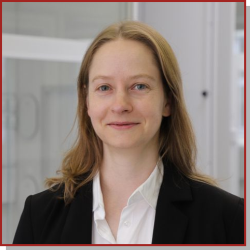
04.07.2022
Talk: Prof. Stefanie Tschierlei
On Friday, July 8, 2022 at 2 pm, Prof. Stefanie Tschierlei (TU Braunschweig) gave a talk on the topic:
CO2 light activation - is it possible?
The talk took place within the joint CRC 1270 ELAINE and CRC 1477 LiMaI lecture series "Women in Natural Sciences and (Bio-)Engineering".
We thank all visitors for their participation!
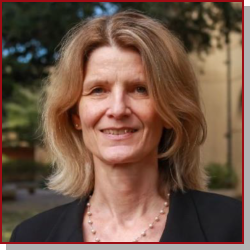
19.05.2022
Colloquium: Prof. Dr. Mette Gaarde
On Thursday, May 19, 2022 at 4:15 pm, Prof. Dr. Mette Gaarde (Louisiana State University, USA) gave a talk at the Doctoral Seminar on the topic:
High-harmonic spectroscopy in 2D and 3D systems: real-space and momentum-space images
We thank all participants!
| 2021 |
|---|
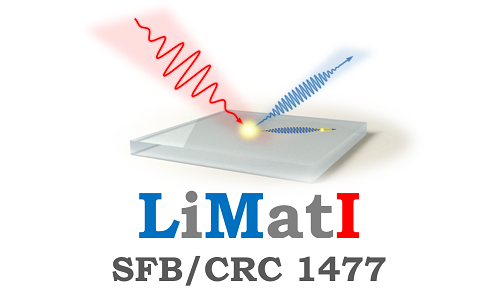
25.11.2021
Collaborative Research Center 1477 LiMatI approved
At its meeting on November 24, 2021, the German Research Foundation (DFG) approved the establishment of the new Collaborative Research Center 1477 LiMatI (Light-Matter Interactions at Interfaces) at the University of Rostock.

